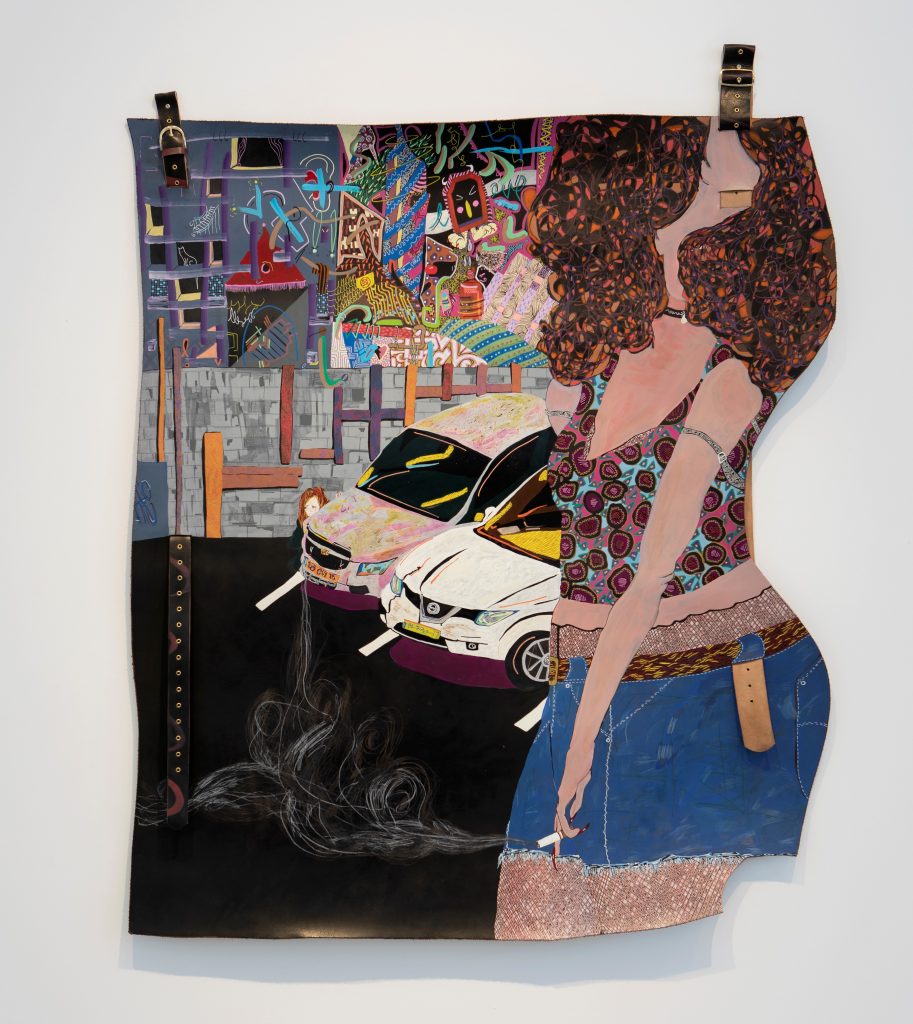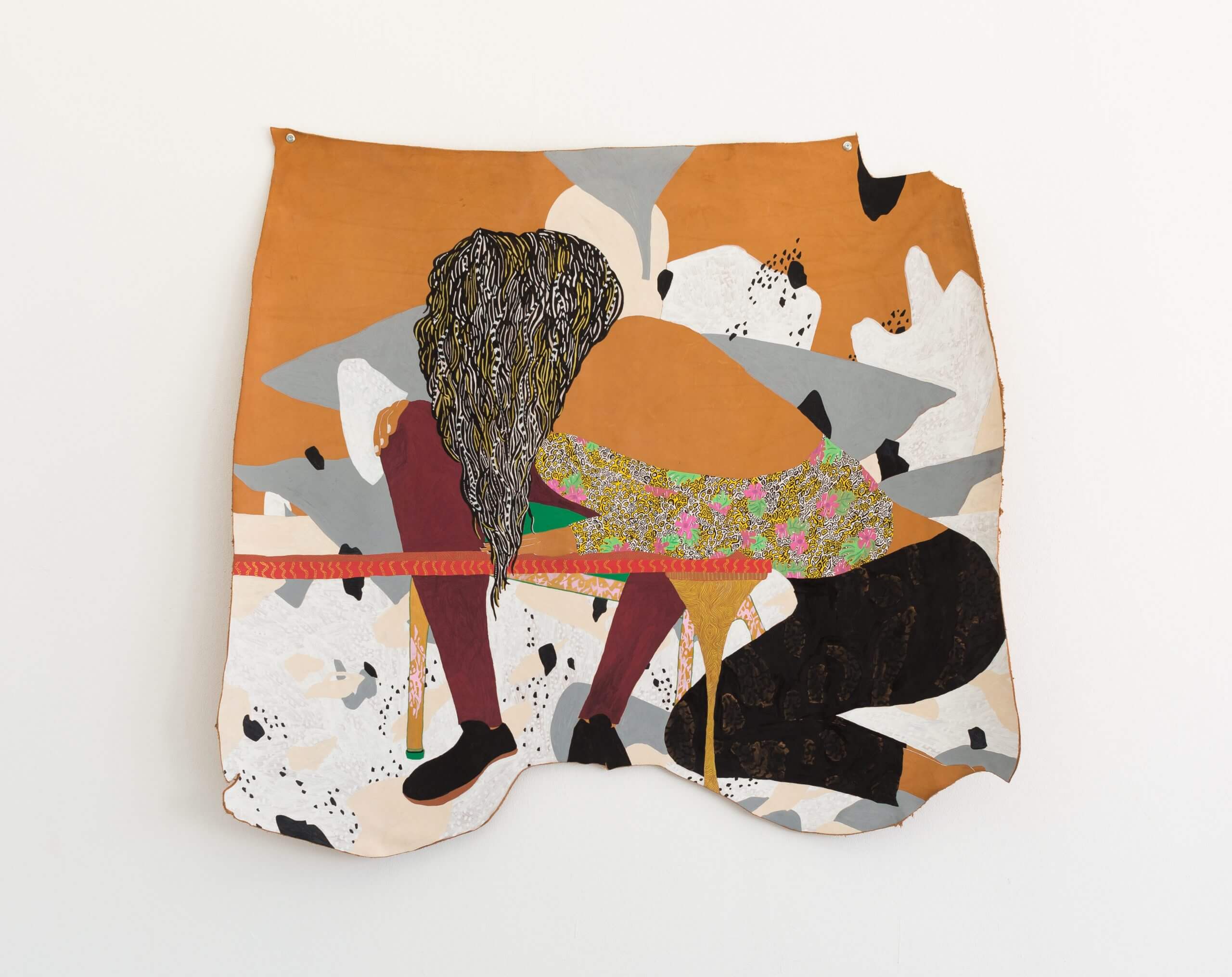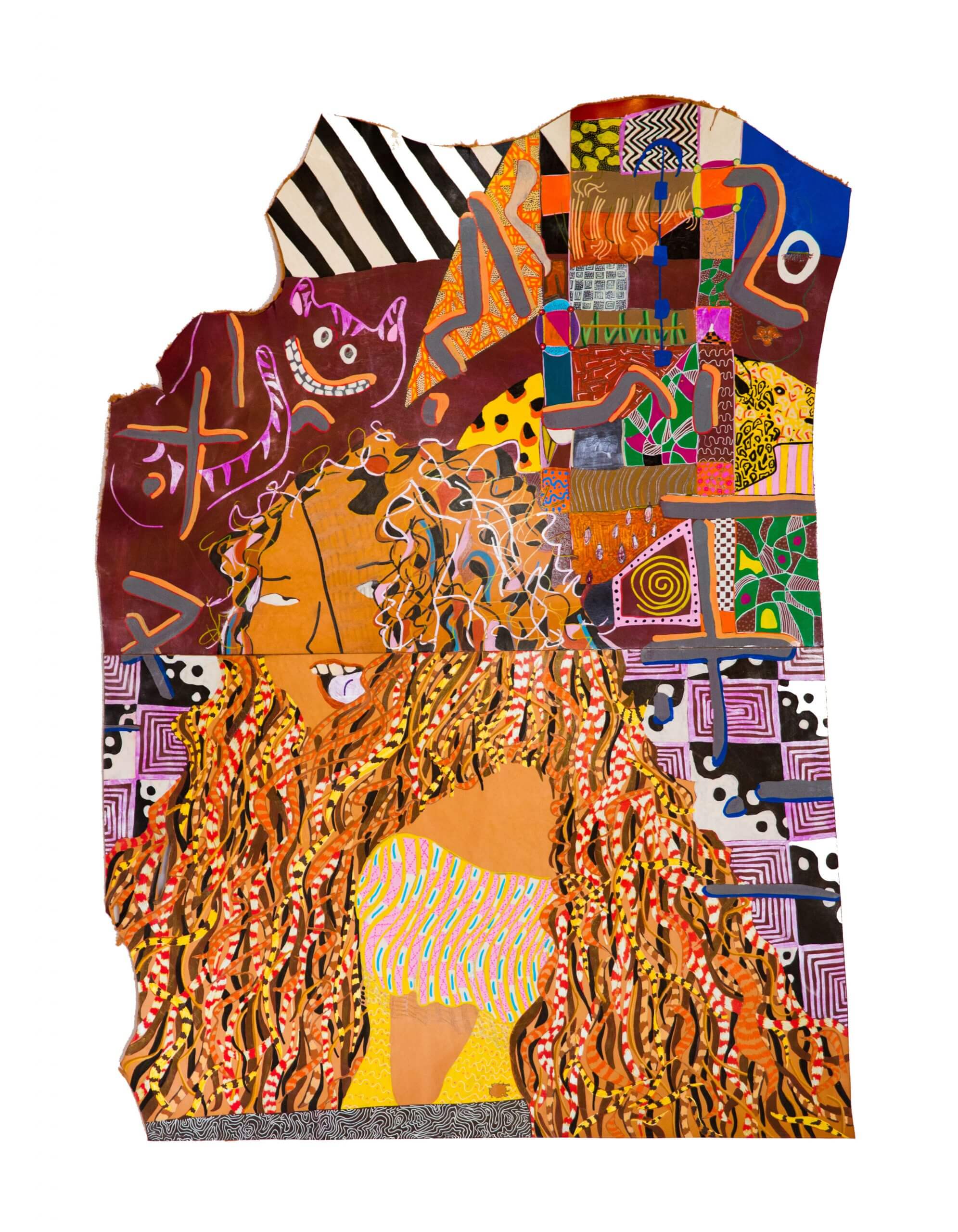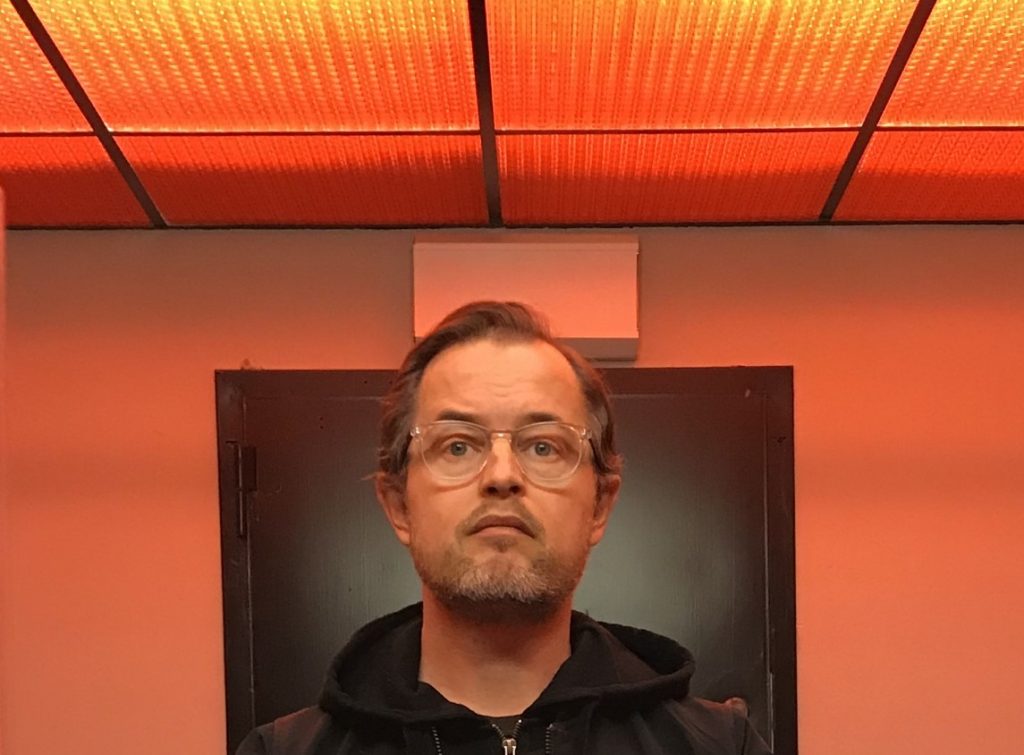About meaning and surface: a conversation with Shir Moran

Shir Moran is an award winning painter and visual artist born and based in Tel Aviv. She studied Fine Art at the Bezalel Academy of Arts and Design Jerusalem, where she completed both her bachelors (2009-2013) and MFA (2015-2017) degrees. In 2018, her work The Girlfriend Experience (2017) won the 2018 Under the Hammer Sotheby’s prize at the Israeli Fresh Paint Art Fair. Her art was featured at the Janco Dada Museum in Ein- Hod, the Herzliya Museum of contemporary art, and Alon Segev Gallery, Tel Aviv.
Using bright combinations of materials, colors, literary motifs and storytelling Moran confronts the boldness of everyday life and the core of art making. Her attention to details makes her works captivating and thought provoking, and observing them is a multisensory experience.
FRONTRUNNER speaks with Moran about the meaning of art making, working in Berlin, lucid dreams, animism and leather.

The Girlfriend Experience (2017)
Mixed media on leather
132 x120 cm
Courtesy of the artist
The nightlife is a recurring theme in your work, both as night scenes from your window view and as scenes of dreams. How do you combine the two and how are they reflected in your creative process?
I think that the analogies that are created in my works are like patches, parts combined with one another. They are related to everyday moments I engage with and, of course, when you dream, these moments connect to one another and give us hints about ourselves.
Nightlives are even more vague, and sometimes are associated with substance. Though both take place at night, I have never thought of the way the two themes are fused with one another, but both clearly occupy my thoughts. Both are also related to a release of control and lack of awareness, partial awareness or on the contrary, loose awareness, like in a lucid dream.
Has your work in Berlin affected your art? Was there a new window view that affected your artworks so far?
Yes, I am looking forward to learning how life in a new place would affect my work. Naturally, the place you are based in influences your work, and I already feel it is changing something in mine. Even though I am currently working mostly on sketches and not a new series I can feel that the two months I spent there affected me as I was getting used to a new place.
I visited the National Gallery and the permanent collection of German expressionist art, including artists like Otto Dix, and I feel that the roots of these paintings are very significant to me and are related to my work. Speaking of nightlife and decadence, somehow to me there is a connection between that time period and the present, and that my drawings connect the two.
Many of your artworks are created on leather. What made you focus on leather and how does the material affect the execution of the artwork? When does the shape of the skin dictate the drawing, in a work like Special Attention (2018) and when does the drawing dictate the skin, in a work like Holli (2018) for example?
There are many factors to it. Parchment, one of the first surfaces to be used for writing and drawing, was made of leather, and there is a long tradition to it. I have been working with leather for many years. There is something very natural about painting on it. It is an organic material after all, so the color is absorbed into it in a very good way, similarly to fabric or paper. I usually leave the contour of the work as the original piece that I buy. The piece is a layout of an animal’s body, and it has a meaning in my work. In terms of what dictates what, It is a kind of a game that is balanced as I work with the leather in all sorts of ways. Sometimes I start with a certain image until I get to the edge of the piece, and sometimes the cut would affect whatever joins the imagery I started with. Holli (2018), for example, was a part of a very large series I presented when I participated at the Fresh Paint Art Fair. These were small works and I was involved in the cutting of the leather I used for them.They were not ‘precise’ square shapes; Some looked like someone had ‘bitten’ them because of the original shape of the piece. In Special Attention (2018), as I often do, I take a large piece of leather and slit it, or I draw something flaccid on it, like a stain or a line, and then I slit or cut it into pieces, draw the pieces separately, and put them back together. In Special Attention (2018), for example, there are two pieces of leather, which lead to a kind of a general movement, and an additional internal movement for each separate piece. In other works I would simply paint the entire piece, without cutting or carving it at all.

Special Attention (2018)
Mixed media on leather
88×63 cm
Courtesy of the artist
Speaking of Fresh Paint, you described The Girlfriend Experience (2017) (winner of the 2018 Under the Hammer Sotheby’s prize at Fresh Paint Art Fair) as a painting pretending to be a sculpture.
In RED SKYLINE (2021), my last exhibition at the Alon Segev Gallery, skins were not my main preoccupation. There were also mirrors, rugs, Levi’s 501 jeans, which I unstitched and resewn into a piece that looked like a layout of jeans, of a human’s body, in a similar way to the pieces of leather. These were kinds of object paintings; A painting impersonates a sculpture and deals with the technical traditions of drawing with the way it is created with materials such as acrylics, pencils and markers, but in fact that the painting has an extra dimension to it that is not only aof the drawing, but as an object. You could look at it as a philosophical question, that a painting is always an object, but these artworks, because of the very materials from which they are made, have an additional role in the space.The skins I use are thick, and are often used for upholstery or for footwear, so when you hang them on the wall their edges are slightly curved, as if they want to pop out, to jump. You can even have a peak of what’s behind them. There is something kind of similar to taxidermy to it. That is one of the things that interests me about painting, the ultra-objectivity of it.
It brings me back to your earlier description of lucid dreams in relation to your works, since your works seem to be very self conscious, both in their subject matters and the materials they are made of. Is there any material you would like to work with and have not yet got to explore?
Absolutely. I do not know yet what my future plans are, but I am certain I will experiment and will test all sorts of materials. At some point I also hope to explore oil on canvas; As difficult as it is for me, I hope I will do it someday.
What artists do you look up to at this point of your career? Have you got a chance to work with fellow artists represented by the Alon Segev Gallery?
I have known Sigalit Landau for many years, and I really appreciate her and her work. There is also a direct connection between my work and the work of Tal Mazliach who is represented at the gallery. Both of us preoccupy ourselves with similar patterns. In Eitan Ben Moshe’s latest exhibition at the gallery, The Story of Y (2021), he also explores similar objects to mine; Object-paintings, or rather, paintings-sculptures. In general, there are a lot of artists around the country, and especially female painters,whose work I feel is very much related to mine.Some of them, including Omer Halperin and Efrat Rubinstein, are artists I studied with in my MFA program. The art scene in the country is very interesting at the moment.

What is one great piece of advice you ever received? And what is a not-so-great advice you received, if there is one?
I think that one bad piece of advice I received, and is slightly difficult to phrase, was when I was offered to do certain things that were unnatural for me in order to push my career forward. It can be applied to different people from different fields in various ways.
I am an artist who mostly works alone at the studio. I am interested in collaborating and working with other artists, but I am not a producer or an events planner. So for me, doing these kinds of things that ‘should be done’ when they do not feel natural to your own qualities is not good advice.
One good piece of advice I was given was that if I persisted on doing what I was doing I would persuade the right people to support me.
And is there any advice you would give to a young artist trying to launch a career in this field?
In my opinion working in the arts is both the most difficult and most interesting thing to do. As advice I would say that you need to have a lot of patience, that it does not happen in a day, and one should not expect to have a big breakthrough. At the end of the day it is a matter of a long period of time.
I don’t know if this is such a good piece of advice but that is something I could say to someone who wants it.
I think it is great advice. And it is nice to hear it from an artist that does what she loves for a living.
You really have to insist on continuing to do this thing. There is no rational or economical justification for it, but personally it is very important to me, and it is an important part of our world.
Absolutely. And are there any future projects you would like to mention?
I will be participating in the first group exhibition curated by Meital Amiram in the new gallery space in Shenkar [College of Engineering and Design, Ramat Gan]. In addition to this project I am in a period in my life in which everything is new. I have recently left an apartment and a studio, and my life has evolved and changed. I will probably relocate to another country, but it is still uncertain at the moment.
I think there is something very liberating about it.
Very liberating. It gives you an opportunity to change and to reinvent yourself. It can be scary but it is freeing.
You combine motifs of two-dimensional characters and characters from fairytales in many of your works. Pinocchio, for example, is a recurring character.
Pinocchio was the key figure in Parking Lot Whisper (2019), my previous exhibition at Alon Segev Gallery. But in general I am interested in fairytales, in adaptations of fairy tales, female characters, relationships between female characters, and triangular relationships. Triangles, and triangle relationships fascinate me in my everyday life, and they are translated to many of my works. Some include all kinds of pseudo-princesses, princesses who are prostitutes, prostitutes who are princesses. I am interested in these portrayals, both in our culture and in our very first emotional processing of them as children. Everything is already there.

Parking Lot Whisper (2019)
Mixed media on leather
136×116 cm
Courtesy of the artist
Did you start drawing these characters from an early age or did you start incorporating them during your academic journey?
It’s funny, because it takes me back to the beginning of our conversation when we were talking about Berlin and about my roots. All this motivation for drawing started when I was a kid. There was a book of paintings at my grandparents’ house, and one of the works in the book was The Day After (1895) by Edvard Munch. It was a kind of a woman, a “call girl” as the book described her, lying sprawled on a white bed, with glasses and wine bottles around her. The painting depicted the day after a night of debauchery or of work, with her black hair on the white bedsheets. I was fascinated by this character. I wanted to draw her; I wanted to be her, even though I was a very young girl. When I would watch Disney movies, and other movies as well, it was something I felt towards these characters, specifically the animated ones. I think they have always been there, from my starting point as a woman in this world.
I also have a painting called After Party, which is a specific remake of Munch’s The Day After.
Are you also interested in animation in your own projects?
When I started my bachelor’s degree at Bezalel I studied animation for a year. As I started my second year I remember sitting in a Maya class, which is a 3D animation software and I said to myself “there is no way I am doing this” (laughs). I left the class and switched my major. It took some time to get there, but will I ever do an animation project? You can never know, never say never.
I think it could be a fascinating project, one similar to the collaboration between Salvador Dali and Disney, where they animated his artworks and brought them to life.
A project like that would require a very generous budget, but besides that there are all kinds of ‘resurrections’ in projects like this. Whether you react to the objects, personify them, or attribute them a soul. It is not only animation, but animism, the lives of the objects.
I would say that there is both animation and animism to your works because of the materials you work with.
You can look at artworks in general in this way, as objects with some kind of power to them. Their power is their meaning. That’s what we do; We search for a meaning, whether it is to occupy emptiness, boredom; That could be the very reason to make art.









Responses